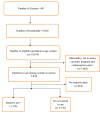Prevalence and factors associated with intention to use contraceptives among women of reproductive age: a multilevel analysis of the 2018 Guinea demographic and health survey
- PMID: 38166935
- PMCID: PMC10759447
- DOI: 10.1186/s12884-023-06204-1
Prevalence and factors associated with intention to use contraceptives among women of reproductive age: a multilevel analysis of the 2018 Guinea demographic and health survey
Abstract
Background: Contraceptive use is a key indicator of improving the health and well-being of women, mothers and their families, preventing unwanted pregnancies, and reducing maternal and child mortalities. Despite a lot of investments from the Government of Guinea to improve contraceptive use, studies reveal that contraceptive use still remains low in Guinea. However, the intention to use contraceptives in Guinea has not been well examined. Therefore, this study seeks to examine the factors associated with the intention to use contraceptives among women of reproductive age in Guinea.
Methods: The study made use of data from the Guinea Demographic and Health Survey (GNDHS) conducted in 2018. For this study, we included a weighted sample of 6,948 women who were either married or cohabiting and responded to all the variables of interest. The data were analyzed using Stata version 14.2. Descriptive and multilevel logistic regression were carried out to examine the factors associated with the intention to use contraceptives. The results of multilevel logistic regression were presented using adjusted odds ratios at 95% confidence intervals and p-value < 0.05 to determine the significant associations.
Results: The prevalence of intention-to-use contraceptives among women was 19.8% (95% CI18.3%-21.5%). Women with secondary/higher educational levels [aOR = 1.58, 95% CI = 1.26-1.99], women whose partners had secondary/higher educational level [aOR = 1.26, 95% CI = 1.04-1.52], women who were cohabiting [aOR = 1.74, 95% CI = 1.13-2.68] and were exposed to mass media [aOR = 1.60, 95% CI = 1.35-1.89] were likely to have higher intentions to use contraceptives. Additionally, women from the Kankan Region [aOR = 4.26, 95% CI = 2.77-6.54] and women who belong to the richer wealth quintile [aOR = 1.36, 95% CI = 0.91-1.89] were likely to have higher odds of intentions to use contraceptives. However, women aged 45-49 years, those from the Peulh ethnic group, and those who lack the competence to make healthcare decisions alone had lower odds of intention to use contraceptives.
Conclusion: The study revealed a low prevalence of intention to use contraceptives among women of reproductive age in Guinea. The study has highlighted that both individual-level and household/community-level factors were significantly associated with the intention to use contraceptives. Therefore, policymakers and stakeholders need to consider these factors discussed in this paper when developing policies and interventions to promote and enhance intention-to-use contraceptives among women of reproductive age in Guinea. The findings call on the Government of Guinea and all stakeholders in Guinea to ensure that female education is promoted to help improve their social status, decision-making on fertility, and reduce fertility rates and maternal mortality.
Keywords: Contraceptives; Guinea; Intention; Prevalence; Public health; SSA.
© 2023. The Author(s).
Conflict of interest statement
The authors declare no competing interests.
Figures
Similar articles
-
Intention to use contraceptives among married and cohabiting women in sub-Saharan Africa: a multilevel analysis of cross-sectional data.BMJ Open. 2022 Nov 24;12(11):e060073. doi: 10.1136/bmjopen-2021-060073. BMJ Open. 2022. PMID: 36424119 Free PMC article.
-
Intention to use contraceptives and its correlates among reproductive age women in selected high fertility sub-saharan Africa countries: a multilevel mixed effects analysis.BMC Public Health. 2023 Feb 6;23(1):257. doi: 10.1186/s12889-023-15187-9. BMC Public Health. 2023. PMID: 36747157 Free PMC article.
-
Unmet need for contraception and its associated factors among women in Papua New Guinea: analysis from the demographic and health survey.Reprod Health. 2022 May 8;19(1):113. doi: 10.1186/s12978-022-01417-7. Reprod Health. 2022. PMID: 35527266 Free PMC article.
-
Four in ten married women demands satisfied by modern contraceptives in high fertility sub-Saharan Africa countries: a multilevel analysis of demographic and health surveys.BMC Public Health. 2022 Nov 24;22(1):2169. doi: 10.1186/s12889-022-14610-x. BMC Public Health. 2022. PMID: 36434551 Free PMC article.
-
Geographic variation and associated factors of long-acting contraceptive use among reproductive-age women in Ethiopia: a multi-level and spatial analysis of Ethiopian Demographic and Health Survey 2016 data.Reprod Health. 2021 Jun 10;18(1):122. doi: 10.1186/s12978-021-01171-2. Reprod Health. 2021. PMID: 34112194 Free PMC article.
Cited by
-
Intention to use modern contraceptives among current nonusers of reproductive age in Uganda.Contracept Reprod Med. 2024 Dec 19;9(1):67. doi: 10.1186/s40834-024-00325-4. Contracept Reprod Med. 2024. PMID: 39702753 Free PMC article.
-
Predictors of intention to use contraceptives among married and cohabiting women in Ghana: A cross-sectional study.Contracept Reprod Med. 2024 Nov 11;9(1):55. doi: 10.1186/s40834-024-00312-9. Contracept Reprod Med. 2024. PMID: 39523361 Free PMC article.
References
MeSH terms
Substances
LinkOut - more resources
Full Text Sources
Research Materials
Miscellaneous



